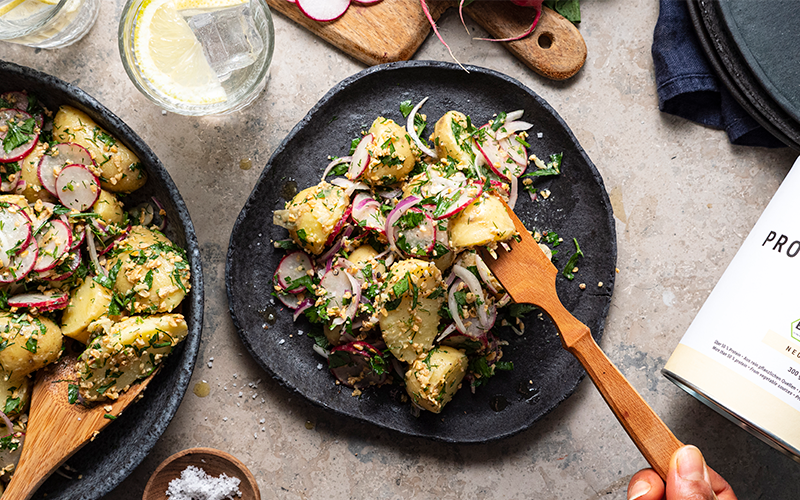Yes, Potatoes Can Be Part of A Healthy Diet—Here’s How
 ©foodspring
©foodspring
Potatoes are a staple in cuisines around the world, for their versatility and jam-packed nutritional profile. Russet, sweet, blue, purple, fingerling — all potatoes can be a boon to your diet. Here’s how to add them into your healthy lifestyle.
What’s the nutritional value of potatoes?
Yes, potatoes get a bad rap. But that’s mostly because of the way they’re often prepared. (We’re not going to surprise anyone by saying deep fried foods, whether they’re smothered in chili and cheese or not, are a fun treat but not great as standard fare). But on their own, potatoes are actually pretty great.
Related: How to lose weight without dieting: 13 tips to your feel-good body
What’s in a potato, anyway?
One medium baked skin-on potato is 161 calories, and scores 17 on the glycemic index—which isn’t bad for a food that’s 92% carbohydrates, 7% protein, and 1% fat. And it contains about a third of your daily value for vitamins B6 and C, as well as potassium, which is important for nerve and muscle functions, as well as maintaining a healthy blood pressure.
Sweet potatoes have a similarly robust nutritional profile. One medium spud has a glycemic load of 10, and will run you 105 calories. And it boasts a whopping 438% of your daily vitamin A needs, which acts like an antioxidant and is important for cell function, vision, and immunity. And its 4 grams of dietary fiber help balance out the 13 grams of naturally occurring sugar. Pro tip: to optimise the amount of fiber in any type of potato, leave the skin on. Just make sure you buy organic and scrub it well!
Potatoes contain resistant starch
The nutritional value of a potato depends on whether it’s raw or cooked, hot or cold. That’s because of the type of starch each of these contains.
Many plant-based foods, such as grains and potatoes, naturally contain starch. Starch is a complex sugar also known as a polysaccharide. The starch molecules in potatoes burst during cooking, enabling our bodies to more easily break them down. If you eat a cooked potato that’s still hot, your body uses a certain combination of enzymes to break down the starch into small sugar molecules, and these polysaccharides supply us with a bunch of energy.
Refuel: Supplement your diet with our whey protein powders
After the starch has cooled back down, though, so too does our ability to digest it. Molecules in the starch crystallize into something called resistant starch, which has a harder time being broken down by our body’s enzymes. As a result, they pass through our digestive system and are only broken down by intestinal bacteria at the tail end of their journey.
Related: What else does your body need? Find out in our Body Check!
Healthy potato recipes
Potatoes are like a blank canvas for all of your culinary adventures. That, and their ability to grow in different climates with varying soil qualities, make them a staple in many different cuisines. Here are some innovative ways to prep your potatoes that can act as a main dish or a side.
- Guacamole and Beans Stuffed Sweet Potatoes (serves 1)
Heat oven to 375 degrees. Scrub a sweet potato, poke holes in it with a fork, and bake on a baking sheet until fork-tender, 45 minutes. In a bowl, combine 1 small diced tomato; ½ avocado, mashed; and ¼ finely diced red onion. Season guacamole with lime juice, cilantro, salt, freshly ground pepper, and chili flakes to taste. Transfer potato to plate, slice it down the middle, and top with 2 oz kidney beans, guacamole, and Greek yogurt or sour cream. Garnish with cilantro, if using.
If you want to speed up the baking process by half, prior to it hitting the oven, poke the potato with holes, place in a microwave-safe dish, and zap it for about five minutes, turning once halfway through.
- Field Salad With Fried Sweet Potatoes (serves 1)
Cut a cleaned, scrubbed sweet potato into 1-inch flat pieces. Heat 1 Tbsp coconut oil and fry potatoes until fork-tender, turning frequently, 10 minutes. Season with salt and freshly ground black pepper. In a bowl, toss together greens, halved cherry tomatoes, sliced avocado, extra virgin olive oil, balsamic vinegar, and pepitas. Top with sweet potato.
- Fish and Steak Fries With Creamy Dip (serves 1)
To make the potatoes, heat the oven to 375 degrees. Scrub a potato, slice it lengthwise into spears, toss with extra virgin olive oil, arrange in a single layer on a baking sheet, and bake until fork tender, flipping halfway, 30 minutes. In a large pan over medium-high heat, heat 1 Tbsp extra virgin olive oil; fry potatoes until they are golden on both sides, flipping constantly, 5 to 10 minutes. Season potatoes with salt and freshly ground black pepper. To make the dip, combine ½ cup low fat Greek yogurt with 2 tsp flax oil, salt, freshly ground black pepper, and torn fresh herbs, such as parsley. Serve with cooked fish, such as herring or cod.
- Sweet Potato Chicken Bowl (Serves 1)
Heat oven to 375 degrees. Wash a sweet potato and cut into ½-inch rounds. On a baking sheet, arrange potato, 5 oz chicken breast, and ½ cup broccoli florets in a single layer. Drizzle olive oil over vegetables and chicken, and season with salt, freshly ground black pepper, and paprika. Bake until potatoes are fork-tender and chicken reaches an internal temperature of 165 degrees, 30 minutes. Let chicken rest, 5 minutes; slice into ¾-inch pieces. In a small bowl, combine 1 Tbsp tahini, 1 tsp each honey and mustard, a pinch of salt, freshly ground black pepper, and paprika, thinning the mixture with water until it is a dressing consistency. Transfer chicken and vegetables to a large bowl with 2 cups baby spinach. Top with 1 hard boil egg, drizzle with dressing, and top with 1 tsp chia seeds.
Related: Vegan foods for your plant-based lifestyle
More healthy living tips from foodspring:
- Summer Meal Ideas to Stay Cool
- 14 Easy High-Protein Breakfast Ideas
- 12 foods for muscle building that you should always keep in your pantry
Sources for this article
We at foodspring use only high-quality sources, including peer-reviewed studies, to support the facts within our articles. Read our editorial policy to learn more about how we fact-check and keep our content accurate, reliable, and trustworthy.
- https://fddb.info/db/de/lebensmittel/naturprodukt_kartoffeln_gekocht_ohne_schale_gesalzen/index.html
- https://fddb.info/db/de/lebensmittel/naturprodukt_suesskartoffel_gekocht_ohne_schale/index.html
- Robertson, T. M.; Alzaabi, A. Z.; Robertson, M. D.; Fielding, B. A. (2018): Starchy Carbohydrates in a Healthy Diet: The Role of the Humble Potato, Nutrients, 10 (11).
- https://fddb.info/db/de/lebensmittel/k-classic_vollkornnudeln_gekocht/index.html
- https://fddb.info/db/de/lebensmittel/k-classic_vollkornreis_gekocht/index.html?nomobile=1

































